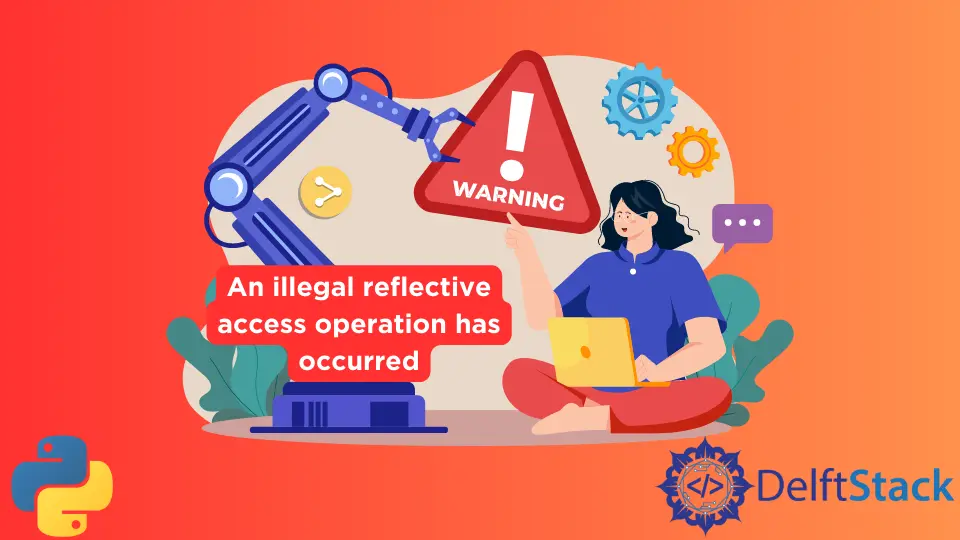How to Solve WARNING: An Illegal Reflective Access Operation Has Occurred
- What Is Reflective Access
- Use Reflective Access
-
What Is the
WARNING: An illegal reflective access operation has occurred -
Reasons and Solutions for the
WARNING: An illegal reflective access operation has occurred - Conclusion

The WARNING: An illegal reflective access operation has occurred is not new. It has been there since Python version 2.2.
This type of exception is a bit of a black sheep from the other exceptions in Python. You could say that it has a different nature and purpose.
This exception is not raised by Python but by the underlying operating system. It indicates that the program tried to access something it should not have.
This means that the problem is not with Python but with the program.
What Is Reflective Access
Reflection is a program’s ability to examine itself, or in other words, to find out information about its structure and behavior. Reflection is used in some contexts in .Net.
Most of the time, reflection is used to create dynamically generated objects.
Reflection is also used for serialization, which converts an object into a stream of bytes. Sometimes, it is used to change the type of an object just after the program has started.
Reflection is a powerful feature that can be used for good, but if you are not careful, it can lead to some terrible things.
Use Reflective Access
With the rise of microservices, we have to face the challenge of making our code interoperable across the entire software ecosystem. RESTful APIs are a popular way of providing programmatic access to resources, but they are not the only option.
The reflection mechanism allows us to examine classes that are not even part of our application.
Reflection is a powerful mechanism of the Java Virtual Machine, which allows us to discover information about our applications’ classes, methods, fields, etc., and any other running Java applications.
The ability to inspect classes and instantiate objects allows us to implement a wide range of functionality without a dependency on a specific class.
What Is the WARNING: An illegal reflective access operation has occurred
An illegal reflective access operation is when a Java application (or applet) attempts to access a class or a field that is not accessible from the class from which the application (or applet) is run.
A class may not access any class that is not accessible to it. The same holds for a field, function, or method.
There are two distinct kinds of illegal reflective access operations. A field can be accessed by a method or a constructor in a class that is not accessible to the class that contains the method or constructor.
This is considered illegal reflective access. A method can be accessed by a class that is not accessible to the class that contains the method.
This warning that an illegal reflective access operation has occurred is also considered illegal reflective access.
Sometimes while running code, we see a message that an illegal reflective access operation had occurred. That warning may be because for different reasons.

Reasons and Solutions for the WARNING: An illegal reflective access operation has occurred
If you see this message, an illegal reflective access operation has occurred. This can happen for several reasons, but most often, it’s because someone is trying to access a resource to which they don’t have permission.
You can also resolve this issue by the following commands.
--illegal-access=permit
--illegal-access=deny
--illegal-access=warn
--illegal-access=debug
All these commands are used to disable all illegal reflective access options. So from these commands, you can run your system and resolve this warning.
If you see this message, you should contact the person or organization responsible for the resource in question and let them know what’s happening. They may be able to help you resolve the issue.
If you’re responsible for the resource, you should ensure that only authorized users can access it. If you’re unsure how to do that, you can get help from a security expert.
In either case, taking this message seriously and taking action to resolve the issue is essential. Ignoring it could lead to serious security problems down the road.
Conclusion
This warning message indicates that your application is trying to access a class or member that it does not have permission to access. This can happen if you use reflection to access a private or protected class or member.
If you are the application developer, you can fix this by ensuring that your application has the appropriate permissions to access the class or member in question. If you are not the developer, you should contact the developer and ask them to fix this problem.
Zeeshan is a detail oriented software engineer that helps companies and individuals make their lives and easier with software solutions.
LinkedIn